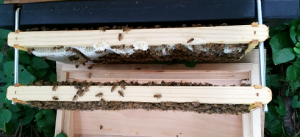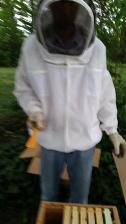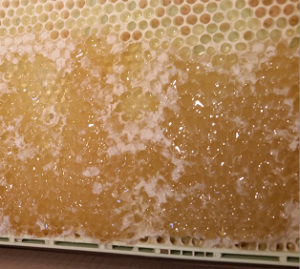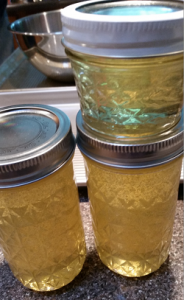Welcome to this week’s bee-log! Last time we focused on the gentlemen who frequent our property, this time let’s take a look at the girls, all ~50,000 of them (not counting Fuzzy)!
 We’ve always tried to support our local volunteer pollinators … primarily by not spraying any chemicals on our property and making sure they have access to water in addition to Fuzzy’s bowl (which has a high mortality rate for bees). Our best homemade bee waterer is a large clay pot base/saucer (~12″ diameter), with a number of small rocks for the bees that can’t swim to haul themselves out of the water onto. I remember several years ago during a dry spell seeing the entire outer rim of the planter filled with bees, head down and shoulder to shoulder, all the way around. It was amazing.We all know pollinators are in trouble, with recent statistics showing that Illinois professional beekeepers lost over 50% of their bees last year (and this is not unusual across the US). All of us need to do everything we can to support bees, so we decided to get some!
We’ve always tried to support our local volunteer pollinators … primarily by not spraying any chemicals on our property and making sure they have access to water in addition to Fuzzy’s bowl (which has a high mortality rate for bees). Our best homemade bee waterer is a large clay pot base/saucer (~12″ diameter), with a number of small rocks for the bees that can’t swim to haul themselves out of the water onto. I remember several years ago during a dry spell seeing the entire outer rim of the planter filled with bees, head down and shoulder to shoulder, all the way around. It was amazing.We all know pollinators are in trouble, with recent statistics showing that Illinois professional beekeepers lost over 50% of their bees last year (and this is not unusual across the US). All of us need to do everything we can to support bees, so we decided to get some!
The girls arrived last April. We had done some preparation and taken a beekeeping class at Long Lane Honey Bee Farm, which was very helpful, but the reality was sometimes kinda scary. I’ve never really been nervous around bees, at least the occasional ones flying around … or landing on me … when I am outside (but then again, I’ve never been stung). Ben, who has been stung several times, started out a bit more anxious about the process. In the early months, both of us walked very quickly away from the hive on several occasions to outrun …. errr … give them time to simmer down a little bit from being cranky that we were messing with their house.
 We purchased a good quality jacket with integrated hood, but it seems that no matter how tight I cinch down the wrists, a bee will usually manage to creep in there somehow (and ditto up the bottom of the jacket). Luckily bees are the golden retrievers of the stinging insect world and seem to be happy crawling around inside the jacket without stinging (even if it can be a wee bit worrisome to the human that is also inside the jacket).We wanted to leave as much honey in the hive as possible for the winter, so we didn’t take out any of the frames and remove honey during this first season. We did, however, remove the drone combs periodically and were able to harvest a bit of honey off of them. The drone comb, for those who don’t know, is a green hive frame that is swapped out at a frequency that is aligned with the birth cycle of the drones (which are more likely to host mites than the worker bees). By removing the drone comb from the hive and freezing it to kill any mites, you can help keep your hive healthy.
We purchased a good quality jacket with integrated hood, but it seems that no matter how tight I cinch down the wrists, a bee will usually manage to creep in there somehow (and ditto up the bottom of the jacket). Luckily bees are the golden retrievers of the stinging insect world and seem to be happy crawling around inside the jacket without stinging (even if it can be a wee bit worrisome to the human that is also inside the jacket).We wanted to leave as much honey in the hive as possible for the winter, so we didn’t take out any of the frames and remove honey during this first season. We did, however, remove the drone combs periodically and were able to harvest a bit of honey off of them. The drone comb, for those who don’t know, is a green hive frame that is swapped out at a frequency that is aligned with the birth cycle of the drones (which are more likely to host mites than the worker bees). By removing the drone comb from the hive and freezing it to kill any mites, you can help keep your hive healthy.

Because we were only removing one frame every few weeks, we processed the frame manually by scraping off the wax and honey with a small metal spatula and then straining it through a metal colander. It worked fairly well, and we ended up with about 5 cups of honey.
We are interested to crack the hive open this year and see how much honey is left in the hive after the winter (we did use feeder lids purchased from Long Lane Honey Bee Farms to supplement the bees over the winter). We have seen many bees out and about already this spring, and we are hopeful that the hive will start the season healthy and strong!
One other thing that we are excited about is that we participated in a funding campaign for the Flow Hive system last year and, while we didn’t harvest any honey last year, we are hoping we have enough honey this year to check out how well it works (it’s supposed to be super easy to harvest the honey)! I’ll keep you posted!
If you want to have some girls of your own and want to learn more, The Land Connection will be offering a beekeeping class in the not too distant future, so keep an eye open!



